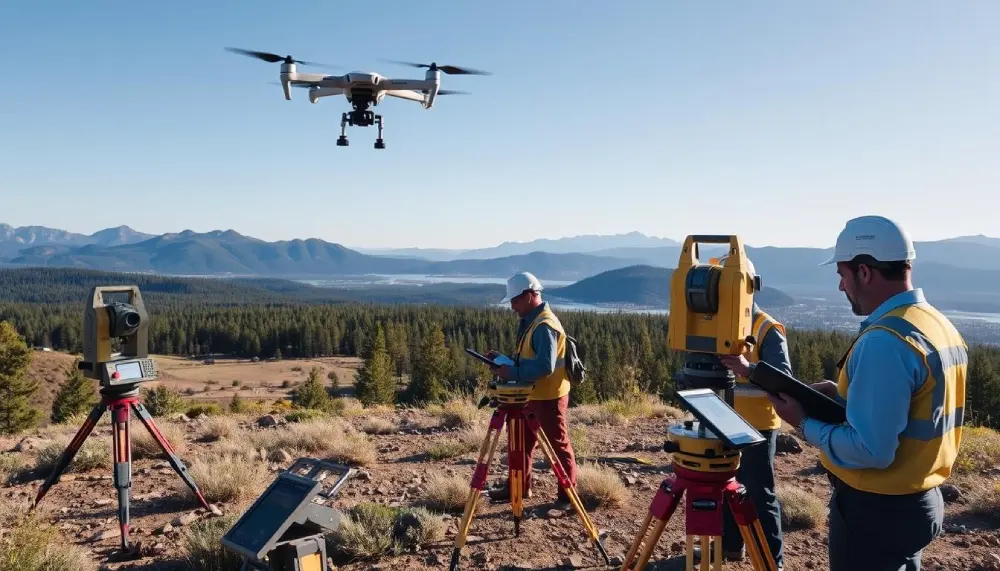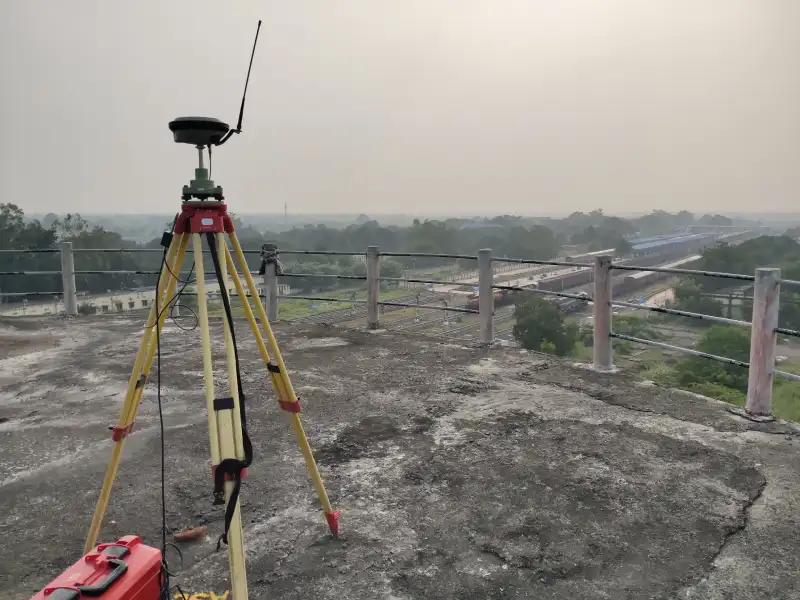Table of Contents

Land surveying is key in today’s world. It’s vital for many reasons. It helps protect property rights and makes sure projects go smoothly.
From setting property lines to checking construction accuracy, it’s crucial. Land surveying is important for many industries.
Land surveying is used in construction, development, and property management. It’s more than just setting property lines. In this article, we’ll see how it impacts different fields.
Key Takeaways
Land surveying is essential for protecting property rights and enabling successful projects.
The importance of land surveying is evident in its application across different sectors.
Land surveying benefits include determining property boundaries and ensuring the accuracy of construction projects.
Understanding the importance of land surveying is crucial for various industries.
Land surveying plays a vital role in modern development.
The land surveying benefits are numerous and extend beyond just determining property boundaries.
Land surveying is vital for construction, development, and property management.
Understanding Why Land Survey Is Important in Modern Development
Land surveying is key in modern development. It defines property boundaries clearly and accurately. This is vital for property rights. It helps avoid boundary disputes and lets property owners use their land without fear of encroachment.
Accurate land surveys are crucial for economic success. They let developers plan and build projects confidently. Land surveying applications include setting property lines, finding environmental risks, and checking if a project can work.
The Foundation of Property Rights
Land surveying is the base of property rights. It clearly shows where property lines are. This is key to stop boundary disputes and let owners use their land freely.
Economic Impact of Accurate Surveys
Accurate land surveys are very important for the economy. They help developers plan and build projects well. Professional surveying reduces risks, making sure projects are done on time and within budget.
Risk Mitigation Through Professional Surveying
Professional surveying reduces risks in construction projects. It finds environmental hazards and checks if projects can work. This helps developers avoid big mistakes and finish projects well.
Accurate determination of property boundaries
Identification of potential environmental hazards
Assessment of the feasibility of construction projects
Mitigation of risks associated with construction projects
Understanding land surveying’s role in modern development is important. It helps property owners and developers complete projects well and with low risk.
Essential Applications of Land Surveying in Construction
Land surveying is key in construction, making sure buildings are safe and look good. Surveyors use GPS and GIS to give contractors precise data. This helps them build structures that follow all the rules.
Some main uses of land surveying in construction are:
- Site planning and design
- Construction layout and monitoring
- Ensuring compliance with regulations and building codes
Land surveying is crucial for construction. It spots problems early and reduces risks. With land surveying, projects are done on time, within budget, and to high quality. Accurate land surveys also prevent disputes and save money.
Land surveying also boosts construction project efficiency. It gives contractors the right data to design and build better. More productivity and less waste result from this.
In summary, land surveying is vital in construction. It ensures projects meet high standards, reduces risks, and saves costs. By investing in land surveying, contractors can achieve better results.
| Application | Benefits |
| Site planning and design | Improved accuracy, reduced errors |
| Construction layout and monitoring | Increased efficiency, reduced costs |
| Compliance with regulations | Reduced risk, improved safety |
The Legal Framework and Property Boundaries
Knowing the legal rules about property boundaries is key for landowners. It helps avoid disputes and makes transactions easier. The legal rules define what landowners can and must do with their land.
Land surveyors are vital in helping landowners understand their rights and duties. They create important documents like property deeds and easements. These documents clearly show who owns what and how to access it.
Boundary Dispute Prevention
Land surveyors play a big role in stopping boundary disputes. They accurately map out property lines. Landowners benefit from knowing their rights and avoiding expensive court battles thanks to this.
Legal Documentation Requirements
Land surveyors must prepare legal papers that define property lines and access rights. These include property deeds and easements. The legal system requires these documents to be correct and current. This ensures smooth transactions and prevents disputes.
Technology and Innovation in Modern Land Surveying

land surveying technology
Land surveying technology has changed the game, making surveys faster and more precise. Innovation in land surveying lets surveyors work quicker and more accurately. This cuts down on time and money compared to old methods.
Drones, lidar, and artificial intelligence are key tools in modern land surveying. They help gather detailed data on land shapes, borders, and features. This data is then used to make accurate maps and plans.
The advantages of using these technologies include:
- Increased accuracy and efficiency
- Reduced costs and time
- Improved data collection and analysis
- Enhanced decision-making capabilities
The land surveying field is always getting better, with new tech and methods coming in. By using the latest technology, surveyors can offer better services and improve their work quality.
By leveraging the latest land surveying technology and innovation, surveyors can unlock new opportunities for growth and development, while also improving the accuracy and efficiency of their work.
Environmental Impact and Land Survey Requirements
Land surveying is key in checking how projects affect the environment. It helps find risks to nature and habitats. This way, projects can be done in a way that’s good for the planet.
Surveyors have to meet both project needs and environmental protection. This is a big challenge.
The steps include:
- Wetland delineation to spot sensitive areas
- Topographic analysis to understand the land and risks
- Environmental compliance to follow rules and guidelines
By focusing on environmental impact and survey needs, developers can avoid delays. They can also make sure their projects are done right and are good for the planet.
The main goal of land surveying is to give data for smart decisions. This helps in making a better future for all.
| Land Survey Requirement | Environmental Impact |
| Wetland Delineation | Identification of areas with high conservation value |
| Topographic Analysis | Assessment of potential risks to ecosystems and natural habitats |
| Environmental Compliance | Ensuring that projects meet regulatory requirements and guidelines |

Real Estate Development and Survey Integration
Land surveying is key in real estate development. It gives vital info on property lines, land shape, and the environment. This info helps developers plan and build projects that meet rules and are well done.
Using survey integration in real estate has many benefits. It can increase property value, save costs, and enhance quality.
Some main benefits are:
- Accurate property boundaries and topography
- Compliance with environmental regulations
- Reduced risk of boundary disputes and lawsuits
- Improved project planning and execution
As more people want real estate development, the need for survey integration will grow. Developers can make projects better, greener, and more profitable with new surveying tech.
In short, combining land surveying with real estate development is crucial. It helps projects succeed and be good for the environment. By focusing on survey integration, developers can make properties that are valuable and meet client needs.
| Benefits of Survey Integration | Description |
| Accurate Property Boundaries | Reduced risk of boundary disputes and lawsuits |
| Compliance with Environmental Regulations | Reduced risk of environmental damage and liability |
| Improved Project Planning and Execution | Increased efficiency and reduced costs |
Critical Role of Surveyors in Infrastructure Planning
Surveyors are key in infrastructure planning. They give vital data and know-how for project design and execution. They work with engineers, architects, and others to plan and carry out projects well.
In infrastructure planning, surveyors give accurate data on land shape, property lines, and the environment. This info is vital for building roads, utility lines, and cities. Surveyors help spot problems and find solutions by teaming up with others.
Key Areas of Focus
- Transportation Systems: Surveyors help design and build roads, highways, and public transport.
- Utility Network Mapping: They make detailed maps of water, sewer, and electrical systems.
- Urban Development Planning: Surveyors assist in planning urban areas, including zoning and land use.
Good infrastructure planning needs skilled surveyors for accurate data. Surveyors work with others to create projects that serve communities well.
As infrastructure needs grow, surveyors’ role in infrastructure planning will be more crucial. Their skills and data are key for building sustainable projects that meet community needs.
| Project Type | Surveyor’s Role |
| Transportation Systems | Design and implementation |
| Utility Network Mapping | Creating detailed maps |
| Urban Development Planning | Providing data and expertise |
Conclusion: The Future of Land Surveying in Shaping Our World
Looking ahead, land surveying’s role in shaping our world is clear. Technology is advancing fast, making land surveying more precise and efficient. This will help drive progress in many areas.
Land surveyors will lead in creating smart cities and managing natural resources. They will use new tools and techniques to gather important data. This ensures our communities grow responsibly.
The future of land surveying is full of promise. Professionals will use drones, 3D mapping, and AI to provide deep insights. This will help in planning infrastructure, saving the environment, and improving our living spaces.
Land surveyors will keep shaping a better future for us. They will stay ahead in innovation, playing a key role in many areas. Future generations will live in a better planet as a result.
As the field grows, land surveyors must keep their focus on accuracy, ethics, and customer service. This ensures their work supports sustainable development and community growth. By embracing the future of land surveying, we can make our world better for everyone.
FAQ
What is the foundation of property rights?
Land surveying defines property boundaries clearly and accurately. This is key to property rights. It stops boundary disputes and lets owners enjoy their land without worries.
What is the economic impact of accurate land surveys?
For the economy, accurate land surveys are crucial. They help developers plan and finish projects on time and within budget. This is thanks to the work of land surveyors.
How does land surveying help with risk mitigation in construction projects?
Land surveying is vital for reducing risks in construction. GPS and GIS are used to provide precise data. This data helps contractors build safe, functional, and compliant structures.
What is the role of land surveyors in preventing boundary disputes?
Land surveyors are key in avoiding boundary disputes. They prepare legal documents that clearly show property boundaries. This makes property transactions smooth and efficient.
How do land surveyors ensure environmental compliance in development projects?
Land surveyors must follow environmental rules in their work. They do wetland delineation and topographic analysis. This helps ensure development projects are sustainable and responsible.
How does the integration of land surveying benefit real estate development?
Land surveying is crucial for real estate development. It gives vital info on property boundaries, topography, and environmental conditions. This integration helps ensure projects are well-planned and meet regulations.
- Measurement Units for Length: A Complete Guide for Everyone - February 14, 2025
- LiDAR and Drones in Surveying: The Ultimate 2025 Guide - February 4, 2025
- “Ultimate RTK GPS 2025 How-to Guide: Step-by-Step Instructions” - January 26, 2025

